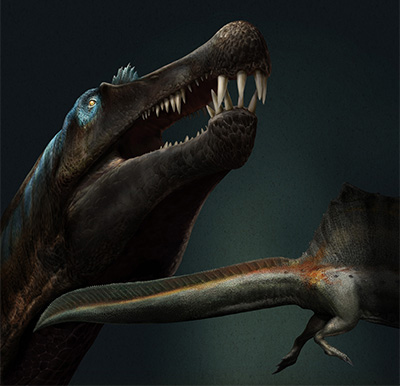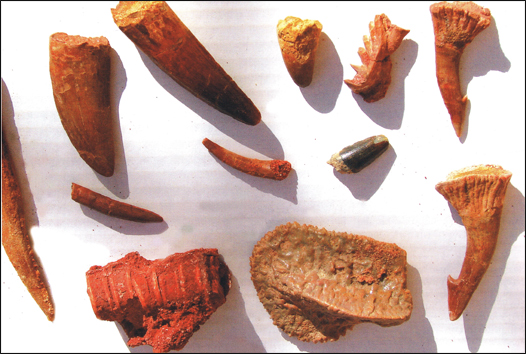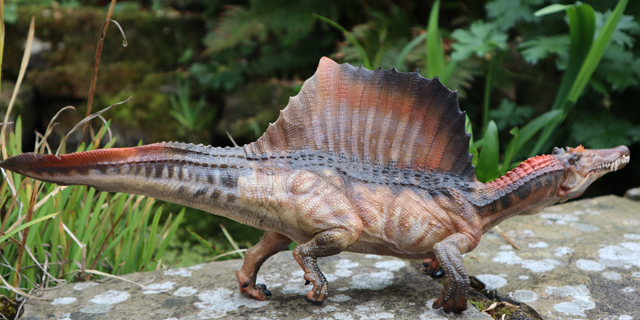Spinosaurus A River Monster
An examination of more than a thousand fossil dinosaur teeth collected from an ancient Cretaceous-aged riverbed in Morocco suggests that the giant theropod Spinosaurus was very much at home in an aquatic environment. This new study, conducted by researchers from the University of Portsmouth, lends further support to the idea that Spinosaurus spent a great deal of time in water, that this enormous theropod, arguably one of the largest of all the carnivorous dinosaurs was a "river monster".
More Evidence Suggests that Spinosaurus was an Aquatic Animal

View of the crocodile-like snout of Spinosaurus and the new interpretation of the tail. This new paper supports the earlier hypothesis that Spinosaurus aegyptiacus was an aquatic animal.
Picture Credit: Davide Bonadonna/National Geographic
This new study builds on a research paper published in the journal "Nature", earlier this year, which also involved co-author Professor David Martill (University of Portsmouth). The May (2020) paper focused on the examination of Spinosaurus aegyptiacus caudal vertebrae, it was concluded that Spinosaurus had a wide, flexible, fin-like tail, ideal for helping the dinosaur to propel itself through the water.
To read more about the Spinosaurus tail bones: Spinosaurus – The River Monster.
A Study of Fossil Teeth from the Kem Kem Formation
Writing in the academic journal "Cretaceous Research", the scientists conclude that Spinosaurus was a water-dwelling dinosaur, a giant "river monster".
A total of 1,200 broken teeth were collected from the site of an ancient riverbed in the Kem Kem Formation of Morocco. Each tooth was carefully analysed and documented and it was discovered that Spinosaurus teeth made up the majority of the fossil specimens.
Professor David Martill, Professor of Palaeobiology at the University of Portsmouth explained:
"From this research we are able to confirm this location as the place where this gigantic dinosaur not only lived but also died. The results are fully consistent with the idea of a truly water-dwelling, "river monster"."
Examples of Typical Fossils from the Kem Kem Formation (Morocco)

Assorted vertebrate fossil remains from the Kem Kem beds of Morocco. The elongated conical tooth (top left) and the large, slender conical tooth which is partially obscured (far left) are likely to be spinosaurid.
Picture Credit: Everything Dinosaur
Around forty-five percent of all the teeth fossils were ascribed to Spinosaurus.
Professor Martill added:
"The huge number of teeth we collected in the prehistoric riverbed reveals that Spinosaurus was there in huge numbers, accounting for 45 per cent of the total dental remains. We know of no other location where such a mass of dinosaur teeth have been found in bone-bearing rock. The enhanced abundance of Spinosaurus teeth, relative to other dinosaurs, is a reflection of their aquatic lifestyle. An animal living much of its life in water is much more likely to contribute teeth to the river deposit than those dinosaurs that perhaps only visited the river for drinking and feeding along its banks."
Professor Martill worked alongside two students (Aaron Quigley and Thomas Beevor), studying for the Masters Degree in Palaeontology at the university.
Thomas Beevor commented:
"The Kem Kem riverbeds are an amazing source of Spinosaurus remains. They also preserve the remains of many other Cretaceous creatures including sawfish, coelacanths, crocodiles, flying reptiles and other land-living dinosaurs. With such an abundance of Spinosaurus teeth, it is highly likely that this animal was living mostly within the river rather than along its banks."
Identifying Spinosaurus Teeth
Sorting fossil teeth can be quite a challenging process. However, enough is known about the Kem Kem biota to enable most of the teeth remains to be assigned to a genus or at least at the family level. Numerous theropod dinosaurs are known from this geological formation, but spinosaurid teeth are distinctive. They are conical, lack serrations and are not recurved. Aaron Quigley explained that the teeth of Spinosaurus have a distinct surface. They have a smooth, round cross-section which glints when held up to the light.
A Model of Spinosaurus Introduced in 2019 (Papo Spinosaurus)

The Papo Limited Edition Spinosaurus dinosaur model (2019). Depicting Spinosaurus as an aquatic animal with deep, fin-like tail.
Picture Credit: Everything Dinosaur
The Sigilmassasaurus Confusion
Whilst the prevalence of spinosaurid teeth in the sample might indicate that spinosaurids spent more time in close proximity to the ancient river than other dinosaurs, this research does not represent definitive proof that Spinosaurus was aquatic. It lends weight to the idea. A large amount of spinosaurid teeth associated with the site, could be a result of some form of depositional bias or general taphonomy. In addition, the paucity of Spinosaurus remains from the Kem Kem Formation has led to controversy over the classification of fossil bones. For example, in 1996 a second genus of spinosaurid was named and described from fossilised cervical vertebrae found close to the Tafilalt Oasis in eastern Morocco. This dinosaur was named Sigilmassasaurus brevicollis (Russell), but its taxonomic validity remains in doubt. Sigilmassasaurus may be a valid genus, if it is, then it was very closely related to Spinosaurus aegyptiacus. Other scientists think that S. brevicollis is not a valid genus and a junior synonym of Spinosaurus. It is possible that the teeth involved in this study could represent another type of spinosaurid, other than S. aegyptiacus.
Everything Dinosaur acknowledges the assistance of a media release from the University of Portsmouth in the compilation of this article.
Source: blog.everythingdinosaur.co.uk

Комментариев нет:
Отправить комментарий